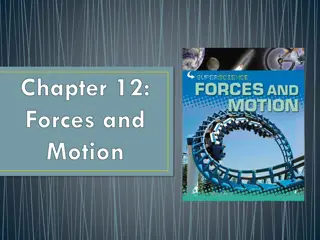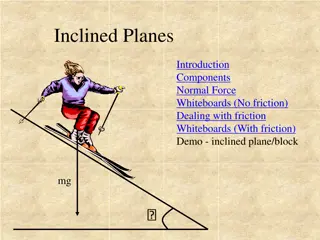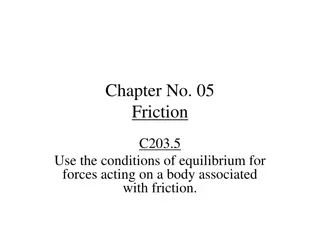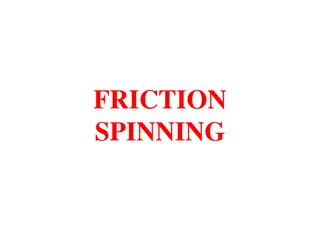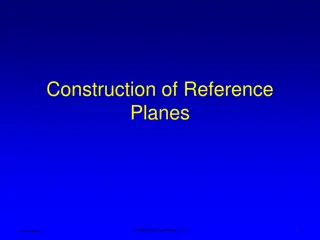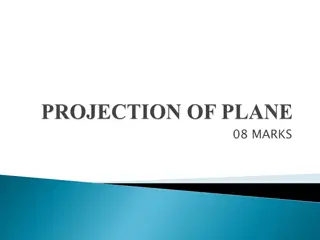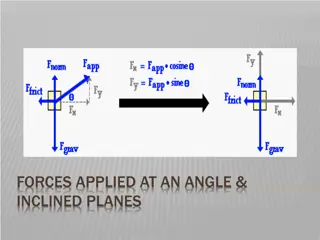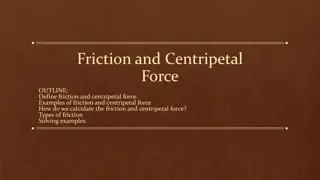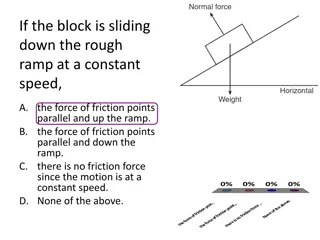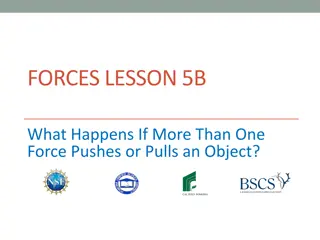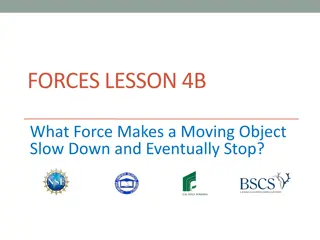Understanding Forces and Friction on Inclined Planes
Explore the concept of forces and friction on inclined planes, focusing on the terminology and calculations involved. Learn how to resolve forces parallel and perpendicular to the plane, split gravity components, and consider normal reactions. Practice problems included to facilitate understanding.
Download Presentation

Please find below an Image/Link to download the presentation.
The content on the website is provided AS IS for your information and personal use only. It may not be sold, licensed, or shared on other websites without obtaining consent from the author. Download presentation by click this link. If you encounter any issues during the download, it is possible that the publisher has removed the file from their server.
E N D
Presentation Transcript
Teachings for Exercise 5B
Forces and Friction Note that when using an inclined plane, we use the terminology parallel for movement direction and perpendicular for the normal reaction You can extend this process to particles on an inclined plane, by considering forces parallel and perpendicular to the plane This is actually exactly the same as with a horizontal plane! (horizontal = parallel and vertical = perpendicular) Inclined plane Horizontal plane Normal reaction Normal reaction Direction of movement Weight Weight We resolve parallel to the plane for the direction of movement We resolve perpendicular to the plane for the normal reaction The weight still acts vertically We resolve horizontally for the direction of movement We resolve vertically for the normal reaction The weight acts vertically 5B
Forces and Friction R You can extend this process to particles on an inclined plane, by considering forces parallel and perpendicular to the plane 60 3gCos30 30 When an object is on an inclined plane, we consider the forces acting parallel to the plane and perpendicular to the plane (instead of vertically and horizontally) 3g 30 90 3gSin30 Above is a box resting on a plane inclined at an angle of 30 to the horizontal Label gravity, which always acts vertically downwards This is because any movement will be parallel to the plane (and we always then consider the direction which is perpendicular to any movement) Gravity must then be split into the parallel and perpendicular components (rather than horizontal and vertical) The angle in the triangle created is the same as the angle the plane is inclined at (if you work out angles you can see why!) Make sure you think carefully about which is Sine and which is Cosine! Don t forget the normal reaction, and any other forces which are involved in the question! However, gravity will always work in a vertical direction so must be split into parallel and perpendicular directions 5B
Forces and Friction R 2N You can extend this process to particles on an inclined plane, by considering forces parallel and perpendicular to the plane 2gCos20 20 2g A box of mass 2kg is resting on a smooth plane inclined at an angle of 20 to the horizontal. It meets resistance of 2N as it travels down the slope a) Calculate the acceleration of the box down the slope b) If the box starts 10m up the plane, calculate the velocity of the box at the bottom of the plane 20 2gSin20 Resolve parallel to the plane ?( ) ? = ?? Sub in values and resolve parallel 2????20 2 = (2 ?) Work out some parts (to keep accuracy) Round to 2sf as gravity is given to this degree of accuracy 19.6???20 2 = 2? 2.4 = ? (2??) 5B
Forces and Friction R 2N You can extend this process to particles on an inclined plane, by considering forces parallel and perpendicular to the plane 2gCos20 20 2g A box of mass 2kg is resting on a smooth plane inclined at an angle of 20 to the horizontal. It meets resistance of 2N as it travels down the slope a) Calculate the acceleration of the box down the slope 2.4ms-2 b) If the box starts 10m up the plane, calculate the velocity of the box at the bottom of the plane 20 2gSin20 ? = 10 ? = 0 ? =? ? = 2.4 ? =? ?2= ?2+ 2?? Sub in values Remember to use the exact value for a, not the rounded one! ?2= 02+ 2(2.4)(10) ?2= 02+ 2(2.4)(10) Calculate ?2= 47.03 Square root ? = 6.6?? 1 (2??) 5B
Forces and Friction R 2N You can extend this process to particles on an inclined plane, by considering forces parallel and perpendicular to the plane 2gCos20 20 2g A box of mass 2kg is resting on a smooth plane inclined at an angle of 20 to the horizontal. It meets resistance of 2N as it travels down the slope a) Calculate the acceleration of the box down the slope 2.4ms-2 b) If the box starts 10m up the plane, calculate the velocity of the box at the bottom of the plane - 6.6ms-1 c) Find the normal reaction between the box and the plane 20 2gSin20 Resolve perpendicular to the plane ?( ) ? = ?? Sub in values and resolve perpendicular (no acceleration in this direction) ? 2????20 = (2 0) Rearrange ? = 2????20 Round to 2sf as gravity is given to this degree of accuracy ? = 18? 5B
Forces and Friction ? Ensure you label all forces and split into their parallel and perpendicular components You can extend this process to particles on an inclined plane, by considering forces parallel and perpendicular to the plane ??? 2????? ? 2? 4? A particle P of mass 2kg is moving on a smooth slope and is being acted on by a force of 4N that acts parallel to the slope as shown. ? 2????? Remember that ???? =??? ??? The slope is inclined at an angle ? to the horizontal, where ???? =3 out the acceleration of the particle. In this case, ???? =3 5 4. Work 3 4 So draw a triangle with angle ?, opposite side 3 and adjacent side 4 ? 4 You will often encounter questions where the angle is given in this way. A good starting point is to find the corresponding values of ???? and ???? So the hypotenuse will be 5 ???? =??? ???? =??? ??? ??? ???? =3 ???? =4 5 5 5B
Forces and Friction ???? =3 ? Ensure you label all forces and split into their parallel and perpendicular components 5 You can extend this process to particles on an inclined plane, by considering forces parallel and perpendicular to the plane ???? =4 ??? 5 2????? ???? =3 ? 2? 4 4? A particle P of mass 2kg is moving on a smooth slope and is being acted on by a force of 4N that acts parallel to the slope as shown. ? 2????? Resolve parallel to the plane The slope is inclined at an angle ? to the horizontal, where ???? =3 out the acceleration of the particle. ?( ) ? = ?? Sub in values and resolve parallel (you can choose up or down the slope) 4. Work 2????? 4 = (2 ?) We can use values for ? and ???? 3 5 2 9.8 4 = 2? Now resolve parallel to the plane Calculate 3.9 = ? (2??) If we had resolved up the slope instead, the acceleration would have been negative You can interpret this as being in the opposite direction to the resolving 5B
Forces and Friction ? You can extend this process to particles on an inclined plane, by considering forces parallel and perpendicular to the plane Ensure you label all forces and split into their parallel and perpendicular components 5? ? ?? 60 5????60 ?????30 30 ?? A particle of mass ? is pushed up a smooth slope by a force of magnitude 5g acting at an angle of 60 to the slope. This causes the particle to accelerate up the slope at 0.5ms-2. 30 ?????30 Resolve parallel to the plane ?( ) ? = ?? Sub in values Show that the mass of the particle is 5? 1+? ?? 5????60 ?????30 = (?)(0.5) Add ?????30 5????60 = 0.5? + ?????30 Cos60 and Sin30 are both equal to 0.5 Resolve parallel to the plane 2.5? = 0.5? + 0.5?? Multiply by 2 Since the particle is accelerating up the slope, it makes sense to take this as the positive direction 5? = ? + ?? Factorise right side 5? = ?(1 + ?) Divide by the bracketed part 5? 1 + ?= ? 5B


